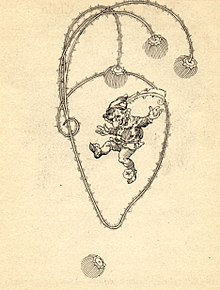Kobolds
|
The kobold Heinzelmann
|
|
| Grouping |
Mythological creature Fairy Sprite |
|---|---|
| Country | Germany |
The kobold (occasionally cobold) is a sprite stemming from Germanic mythology and surviving into modern times in German folklore.
Although usually invisible, a kobold can materialize in the form of an animal, fire, a human being, and a candle. The most common depictions of kobolds show them as humanlike figures the size of small children. Kobolds who live in human homes wear the clothing of peasants; those who live in mines are hunched and ugly; and kobolds who live on ships smoke pipes and wear sailor clothing.
Legends tell of three major types of kobolds. Most commonly, the creatures are house spirits of ambivalent nature; while they sometimes perform domestic chores, they play malicious tricks if insulted or neglected. Famous kobolds of this type include King Goldemar, Heinzelmann, Hödekin. In some regions, kobolds are known by local names, such as the Galgenmännlein of southern Germany and the Heinzelmännchen of Cologne. Another type of kobold haunts underground places, such as mines. A third kind of kobold, the Klabautermann, lives aboard ships and helps sailors.
Kobold beliefs are evidence of the survival of pagan customs after the Christianisation of Germany. Belief in kobolds dates to at least the 13th century, when German peasants carved kobold effigies for their homes. Such pagan practices may have derived from beliefs in the mischievous kobalos of ancient Greece, the household lares and penates of ancient Rome, or native German beliefs in a similar room spirit called kofewalt (whose name is a possible rootword of the modern kobold or a German dialectal variant). Kobold beliefs mirror legends of similar creatures in other regions of Europe, and scholars have argued that the names of creatures such as goblins and kabouters derive from the same roots as kobold. This may indicate a common origin for these creatures, or it may represent cultural borrowings and influences of European peoples upon one another. Similarly, subterranean kobolds may share their origins with creatures such as gnomes and dwarves and the aquatic Klabautermann with similar water spirits.
...
Wikipedia

